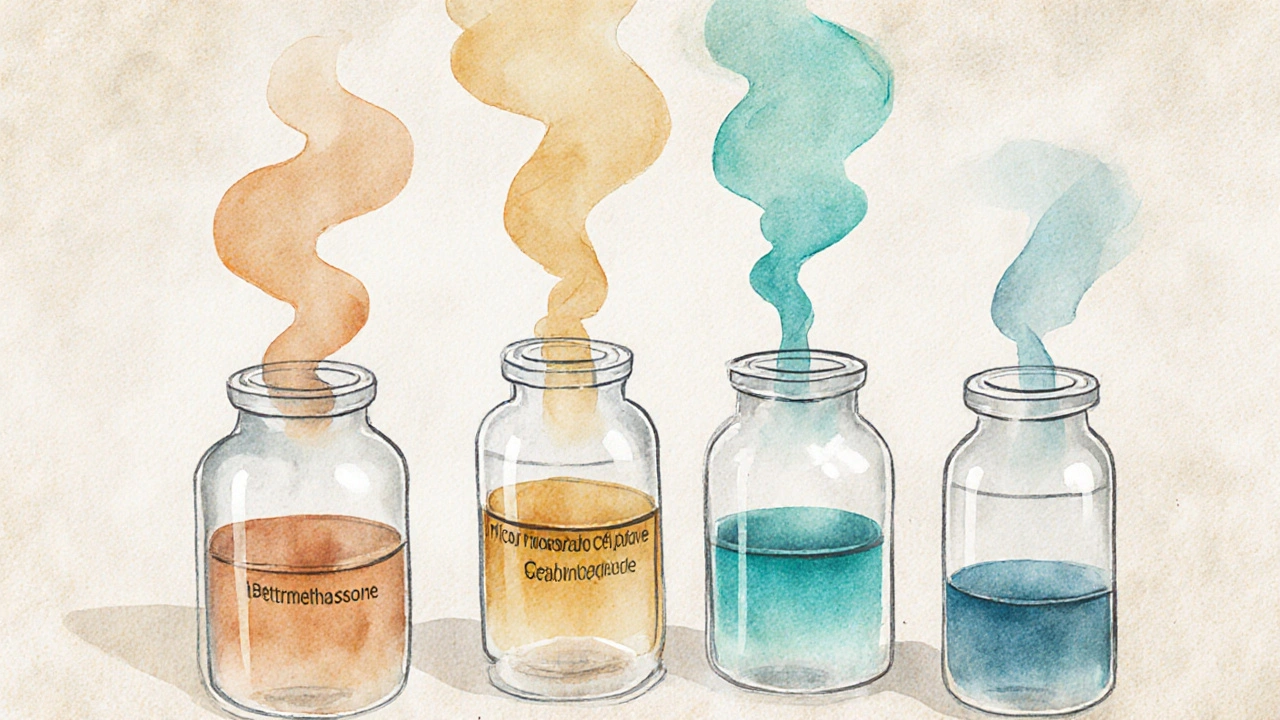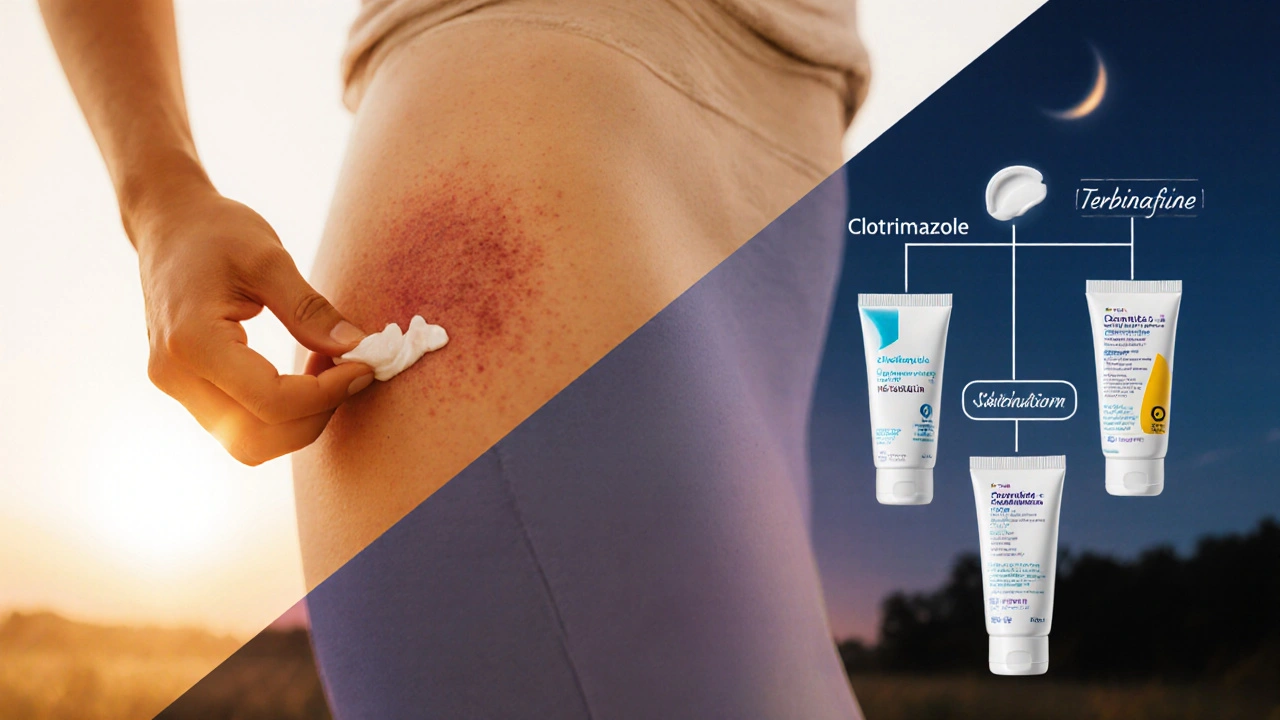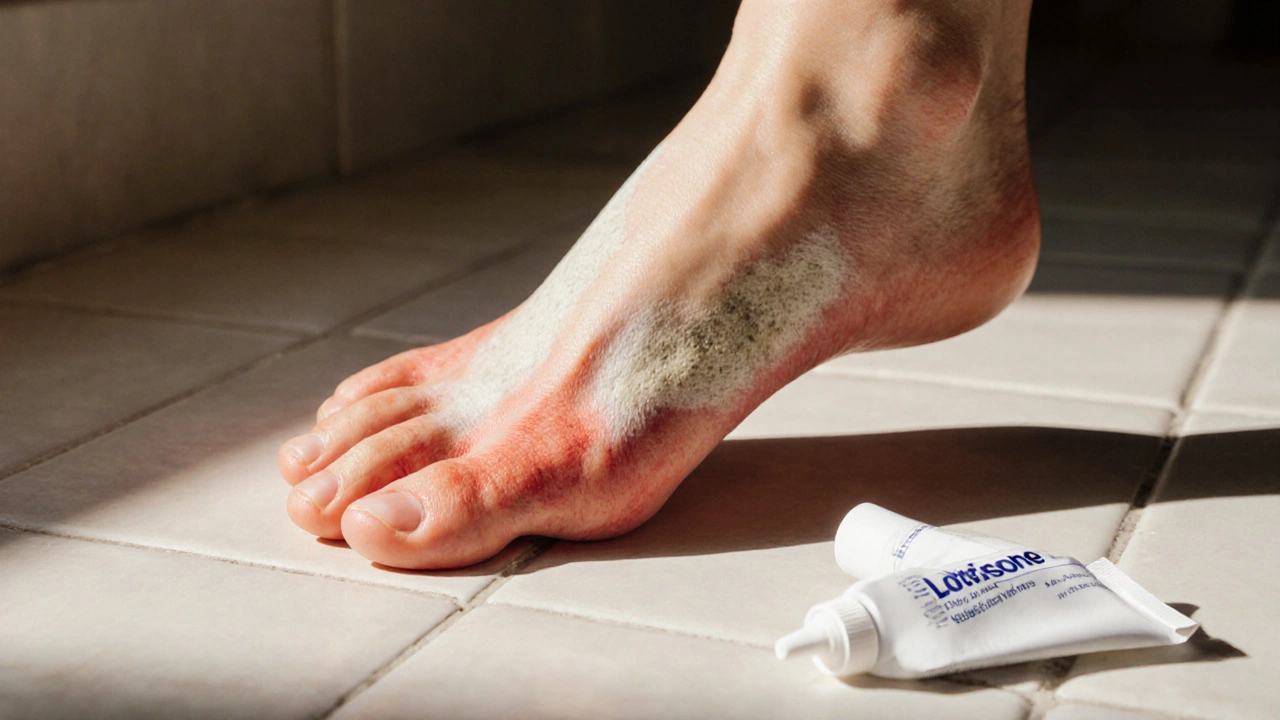Quick Takeaways
- Lotrisone combines a potent corticosteroid (Betamethasone) with a broad‑spectrum antifungal (Clotrimazole) for mixed infections.
- Top alternatives include single‑agent antifungals (miconazole, terbinafine) and non‑steroid combo creams (hydrocortisone+clotrimazole).
- When inflammation is mild, steroid‑free options reduce the risk of skin thinning.
- Prescription status, cost, and treatment duration differ markedly across products.
- Choose based on infection type, severity of inflammation, and any history of steroid sensitivity.
Skin infections that mix fungal overgrowth with inflammation-think athlete’s foot with redness or diaper rash complicated by yeast-often push people toward combo creams. Lotrisone is a topical medication that pairs the corticosteroid betamethasone with the antifungal clotrimazole. While it’s effective, it’s not the only game in town. Below we break down how Lotrisone stacks up against the most common alternatives, so you can pick the right one for your skin.
Understanding the Core Ingredients
Before diving into product comparisons, it helps to know what each active ingredient does.
- Betamethasone is a high‑potency corticosteroid that reduces redness, itching, and swelling by suppressing the immune response in the skin.
- Clotrimazole belongs to the azole class of antifungals; it blocks the synthesis of ergosterol, a key component of fungal cell membranes, halting growth of yeasts and dermatophytes.
- Miconazole works similarly to clotrimazole but tends to be a bit faster against dermatophytes like Trichophyton.
- Terbinafine is an allylamine antifungal that disrupts fungal cell wall synthesis, making it especially potent for athlete’s foot and nail fungus.
- Hydrocortisone is a low‑potency steroid often paired with antifungals for milder inflammation.
- Nystatin targets Candida species specifically, making it a niche alternative for yeast‑only infections.
- Ketoconazole is a broad‑spectrum azole used for severe or resistant cases, often in prescription‑only creams.
Decision Checklist: When to Reach for a Combo vs. a Single‑Agent
Use this quick guide to decide if you really need a steroid‑antifungal combo.
- Inflammation level: If the rash is intensely red, swollen, or itchy, a steroid (betamethasone or hydrocortisone) adds relief.
- Infection type: Dermatophyte (tinea) infections respond well to miconazole or terbinafine; Candida‑dominant rashes may need clotrimazole or nystatin.
- Duration of use: Steroid‑containing creams are generally limited to 2‑4 weeks to avoid skin thinning; single‑agent antifungals can be used longer.
- Prescription vs. OTC: Betamethasone (in Lotrisone) requires a prescription in most countries, while many alternatives are OTC.
- Cost sensitivity: OTC options typically cost less per tube than prescription combos.
Side‑Effect Profile Comparison
Side effects often drive the decision. Below is a concise look at the most common adverse events for each class.
- Corticosteroids (betamethasone, hydrocortisone): skin thinning, stretch marks, tachyphylaxis (diminished effect), potential systemic absorption if used over large areas.
- Azole antifungals (clotrimazole, miconazole, ketoconazole): mild burning, itching, rarely allergic contact dermatitis.
- Allylamine (terbinafine): transient redness, rare hypersensitivity.
- Nystatin: usually well‑tolerated; occasional irritation.
Head‑to‑Head Comparison Table
| Product | Active Ingredients | Primary Indication | Prescription? | Typical Cost (US$) | Pros | Cons |
|---|---|---|---|---|---|---|
| Lotrisone | Betamethasone 0.1%+Clotrimazole 1% | Inflamed fungal infections (e.g., tinea with erythema) | Yes | $30‑$45 (30g tube) | Fast inflammation relief + fungal eradication | Potential skin thinning; limited OTC availability |
| Miconazole+Hydrocortisone | Miconazole 2%+Hydrocortisone 1% | Mild‑to‑moderate inflamed fungal infections | OTC (in many regions) | $12‑$20 (30g tube) | Lower steroid potency reduces thinning risk | Less powerful anti‑inflammatory effect than betamethasone |
| Clotrimazole alone | Clotrimazole 1% | Pure fungal infections without significant inflammation | OTC | $8‑$15 (20g tube) | Minimal steroid‑related side effects | No anti‑inflammatory action; may need adjunctive steroid |
| Terbinafine cream | Terbinafine 1% | Dermatophyte infections (athlete’s foot, ringworm) | OTC (US); prescription in some countries | $10‑$18 (20g tube) | Fast fungicidal action, often cures in 2‑4weeks | Does not address inflammation; possible mild burning |
| Ketoconazole 2% | Ketoconazole 2% | Resistant or widespread fungal infections | Prescription | $25‑$35 (30g tube) | Broad spectrum, good for difficult cases | Potential for systemic absorption if over‑used; higher cost |
| Nystatin cream | Nystatin 100,000IU/g | Candida‑specific skin infections (diaper rash, intertrigo) | OTC (in many regions) | $7‑$12 (15g tube) | Targeted against yeast; low irritation | Inactive against dermatophytes; not for mixed infections |

Practical Use Guidelines for Lotrisone
If you and your clinician decide Lotrisone is right for you, follow these steps to get the best results while minimizing risks.
- Wash and gently dry the affected area; pat with a clean towel.
- Apply a thin layer (about the size of a pea) to the lesion twice daily.
- Rub in gently; avoid occluding the area with tight bandages unless directed.
- Track improvement; if redness persists after 7‑10days, consult your doctor for a possible switch.
- Do not exceed a 2‑week course without medical review, as prolonged steroid exposure can thin skin.
When to Switch Away from Lotrisone
Even a powerful combo isn’t always the best long‑term solution. Consider switching if you notice:
- Persistent skin thinning, stretch marks, or easy bruising.
- Worsening fungal signs despite steroid relief (possible resistant organism).
- Allergic reactions-burning, itching, or hives-after the first few applications.
- Need for treatment beyond four weeks; a steroid‑free antifungal can safely be continued.
In those cases, a single‑agent option like terbinafine or a low‑potency combo (hydrocortisone+clotrimazole) often does the trick.
Cost and Accessibility Snapshot
Budget matters for many patients. Here’s a quick rundown:
- Lotrisone: Prescription; insurance may cover partially; out‑of‑pocket $30‑$45.
- Miconazole+Hydrocortisone OTC: $12‑$20, widely available at drugstores.
- Clotrimazole alone: $8‑$15, easy to find in generic form.
- Terbinafine cream: $10‑$18 OTC in the U.S., similar price abroad.
- Ketoconazole prescription: $25‑$35, may be reimbursed for severe cases.
Bottom Line: Which Product Fits Your Situation?
Summarizing the trade‑offs helps you land on a clear choice.
| Scenario | Best Choice | Why |
|---|---|---|
| Severe redness + confirmed fungal infection | Lotrisone | High‑potency steroid + effective antifungal in one tube |
| Mild redness, mostly fungal | Clotrimazole alone or Miconazole | Avoids steroids, lower side‑effect risk |
| Candida‑only diaper rash | Nystatin | Targeted yeast action, gentle on infant skin |
| Athlete’s foot resistant to azoles | Terbinafine | Fungicidal, works faster on dermatophytes |
| Budget‑conscious, mild inflammation | Miconazole+Hydrocortisone OTC | Cheaper, lower steroid strength |
Frequently Asked Questions
Can I use Lotrisone for nail fungus?
Lotrisone is formulated for skin and mucosal surfaces. Nail fungus requires a product that penetrates the nail plate, such as terbinafine lacquer or oral therapy. Using Lotrisone on nails may give temporary relief from inflammation but won’t eradicate the fungus.
How long should I wait before switching from Lotrisone to a steroid‑free antifungal?
A typical course is 2‑4weeks. If the rash looks better after a week and inflammation is low, you can transition to a steroid‑free cream like clotrimazole for the remaining treatment period.
Is it safe to apply Lotrisone on large body areas?
Because it contains betamethasone, covering large areas increases systemic absorption risk. Doctors usually limit use to less than 10% of body surface area and advise short‑term use only.
Can I buy Lotrisone without a prescription online?
In most countries, betamethasone is prescription‑only, so legitimate online pharmacies will ask for a doctor’s approval. Be wary of unverified sites selling it OTC; the product may be counterfeit.
What should I do if I develop a rash after using Lotrisone?
Stop using the cream immediately. Clean the area with mild soap and water, then apply a bland emollient. Contact a healthcare professional; they may prescribe a different antifungal or a steroid‑free soothing ointment.

Next Steps for You
If you’re still unsure, follow this quick decision tree:
- Do you have strong redness and swelling?
Yes → Consider Lotrisone (prescription) or Miconazole+Hydrocortisone (OTC). - Is the infection limited to skin with little inflammation?
Yes → Choose a single‑agent antifungal like clotrimazole, miconazole, or terbinafine. - Are you treating a Candida‑only rash (e.g., diaper rash)?
Yes → Nystatin is the most targeted, low‑risk option. - Do you need a long‑term solution beyond 4weeks?
Yes → Switch to steroid‑free antifungal after initial inflammation control.
Armed with the comparison above, you can talk to your pharmacist or doctor with confidence and pick the cream that matches your symptoms, budget, and safety preferences.

mitch giezeman
October 4, 2025 AT 12:32When you’re picking a cream for a mixed fungal and inflammatory rash, the key is to match the potency to what you actually need. Lotrisone packs a high‑potency steroid (betamethasone) together with clotrimazole, which makes it a fast‑acting option for red, swollen lesions. The downside, however, is that betamethasone can thin the skin if used beyond a couple of weeks. For patients with mild erythema, a low‑potency hydrocortisone combo or a single‑agent antifungal often does the trick. Cost is another factor; prescription Lotrisone can set you back $30‑$45, whereas over‑the‑counter azoles are typically under $15. Insurance may cover the prescription, but copays can still add up. From a pharmacological perspective, clotrimazole’s azole mechanism interferes with fungal ergosterol synthesis, while betamethasone suppresses local immune responses. This dual action is useful when inflammation masks the fungal infection, but it also masks the signs that tell you the fungus is clearing. If you stop the steroid too early, you might see a rebound of redness, leading you to think the treatment failed. Conversely, continuing the steroid too long increases the risk of telangiectasia and striae. Many clinicians therefore start with Lotrisone for a brief 7‑10 day course, then switch to a steroid‑free antifungal to finish the treatment. The table in the article nicely compares typical durations: Lotrisone is usually limited to 2‑4 weeks, while terbinafine can be used for up to 6 weeks. Another practical tip is to apply a thin pea‑sized layer and avoid occluding the area with tight dressings unless directed. Remember to monitor the rash; if the inflammation subsides but the fungal edge persists, you’re likely ready to drop the steroid. Ultimately, the decision hinges on the severity of inflammation, the specific pathogen, and your personal tolerance for potential side effects.
Kelly Gibbs
October 5, 2025 AT 02:25The table makes the differences pretty clear.
KayLee Voir
October 5, 2025 AT 16:19I agree, and adding that you can often start with a low‑potency combo and step up if needed helps avoid unnecessary steroid exposure.
Bailey Granstrom
October 6, 2025 AT 06:12Honestly, most people over‑prescribe Lotrisone when a simple azole would do.
Melissa Corley
October 6, 2025 AT 20:05But why bother with all that when you can just slap on some aloe and hope for the best 😂
Kayla Rayburn
October 7, 2025 AT 09:59While natural remedies sound appealing, they often lack the antifungal strength needed for dermatophytes.
Dina Mohamed
October 7, 2025 AT 23:52Great summary! 👍 The cost breakdown really helps when you’re budgeting for a month‑long treatment.
Kitty Lorentz
October 8, 2025 AT 13:45I hear you, finances can be a pain, especially when insurance won’t cover the prescription combo.
inas raman
October 9, 2025 AT 03:39Hey folks, remember that proper hygiene-keeping the area dry and clean-boosts any cream’s effectiveness.
Jenny Newell
October 9, 2025 AT 17:32From a pharmacokinetic standpoint, the percutaneous absorption of betamethasone is significantly higher on occluded surfaces.
Kevin Zac
October 10, 2025 AT 07:25Considering the minimum inhibitory concentration (MIC) values, terbinafine often outperforms azoles against Trichophyton species.
Stephanie Pineda
October 10, 2025 AT 21:19That said, if you’re dealing with a mild, localized rash, you might not need the heavy hitter; a short course of clotrimazole can be sufficient. It’s less hassle and you avoid the steroid‑related concerns. Plus, it’s cheaper.
Anne Snyder
October 11, 2025 AT 11:12I’ve tried both Lotrisone and the OTC combo for athlete’s foot, and the OTC was enough for me.
Rebecca M
October 12, 2025 AT 01:05Indeed, the OTC option provides adequate antifungal activity; however, it lacks the anti‑inflammatory potency of betamethasone, which may be necessary in severe cases.
Matt Cress
October 12, 2025 AT 14:59Sure, because everyone loves waiting weeks for a prescription just to get a little less red.
Andy Williams
October 13, 2025 AT 04:52The clinical guidelines actually recommend limiting betamethasone use to no more than two weeks to prevent epidermal atrophy.